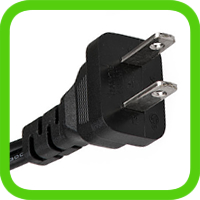




 Canada electrical outlets : do I need a travel adapter?
Canada electrical outlets : do I need a travel adapter?If you go to Canada, you will probably need a travel adapter because they use a specific type of plug (the same as the US). Whether you go to the West of Canada (Yukon, Alberta, Vancouver, ...) or the East (Ontario, Québec, Toronto, Montreal...), you'll find the plugs of type B in Canada.
If you don't come from the United States, you'll probably need a plug adapter to use your electric devices in Canada.
Be careful : the frequency is 60Hz, and the voltage 110 V.
To know if you need a travel plug adapter to go to Canada, you have to consider 3 things : the shape of the plugs, the voltage and the frequency of the current delivered by electrical outlets in Canada.
Here are the shape of the sockets in Canada, and the the types of plugs used in Canada :




If none of your usual plug is compatible, you should buy a travel adapter to be able to plug your electric devices in Canada (please visit our selection on Amazon for more details).

The type of electrical outlets used in Canada is Type A and Type B. Type A outlets have two flat parallel pins and are rated for a maximum current of 15 amps. Type B outlets, on the other hand, have two flat parallel pins with a grounding pin and are also rated for a maximum current of 15 amps.
To charge the battery of your phone or computer in Canada, you can follow these steps:
1. Find a power outlet: Look for an electrical power outlet in your vicinity. Most indoor spaces like homes, offices, airports, hotels, and cafes have power outlets available.
2. Check the voltage: Verify that the voltage rating of the power outlet matches the voltage requirement of your device. In Canada, the standard voltage is 120 volts AC.
3. Get the right adapter: If you are traveling from a country with a different plug type, you might need an adapter to fit your charger into the Canadian power outlet. Adapters can be found in electronic stores or online.
4. Connect the charger: Plug one end of your device's charger cable into the charging port of your phone or computer, and the other end into the power adapter (if required).
5. Plug into the power outlet: Insert the power adapter (if applicable) or the charger plug into the power outlet. Make sure the connection is secure.
6. Monitor the charging: Your device should indicate that it is charging. Most smartphones and laptops display a charging icon, battery level, or a charging LED light. If it doesn't show any signs of charging, double-check the connections.
7. Wait for full charge: Leave your device connected to the charger until it reaches a full charge. The time required may vary depending on your device and battery capacity.
8. Disconnect and unplug: Once fully charged, disconnect the charger cable from your device and unplug it from the power outlet. This helps prevent unnecessary power consumption.
Remember, always use official chargers or trusted third-party chargers to ensure the safety and longevity of your devices. If you encounter any issues or have specific concerns, consult the user manual of your device or contact the manufacturer for guidance.
For Canada, you will need a power adapter that is compatible with the country's electrical standards. Canada uses 120V AC power with a frequency of 60Hz. The standard plug type used in Canada is Type A, which has two flat parallel pins.
To ensure that your device can be used in Canada, you should look for a power adapter with the following specifications:
By selecting a power adapter with these specifications, you can safely and conveniently use your electronic devices in Canada without any compatibility issues.
The top 20 largest cities in Canada, based on population, are: